Key takeaways:
- Light schedules are crucial for cannabis growth, with different durations needed for vegetative (18 hours) and flowering stages (12 hours).
- The quality of light, including the spectrum (blue for vegetative growth and red for flowering), significantly influences plant health, bud structure, and flavor profiles.
- Adjusting light schedules based on environmental factors and growth stages can enhance overall plant development and yield.
- Flexibility in light management can lead to surprisingly positive results, as plants often adapt well to changes in their light conditions.
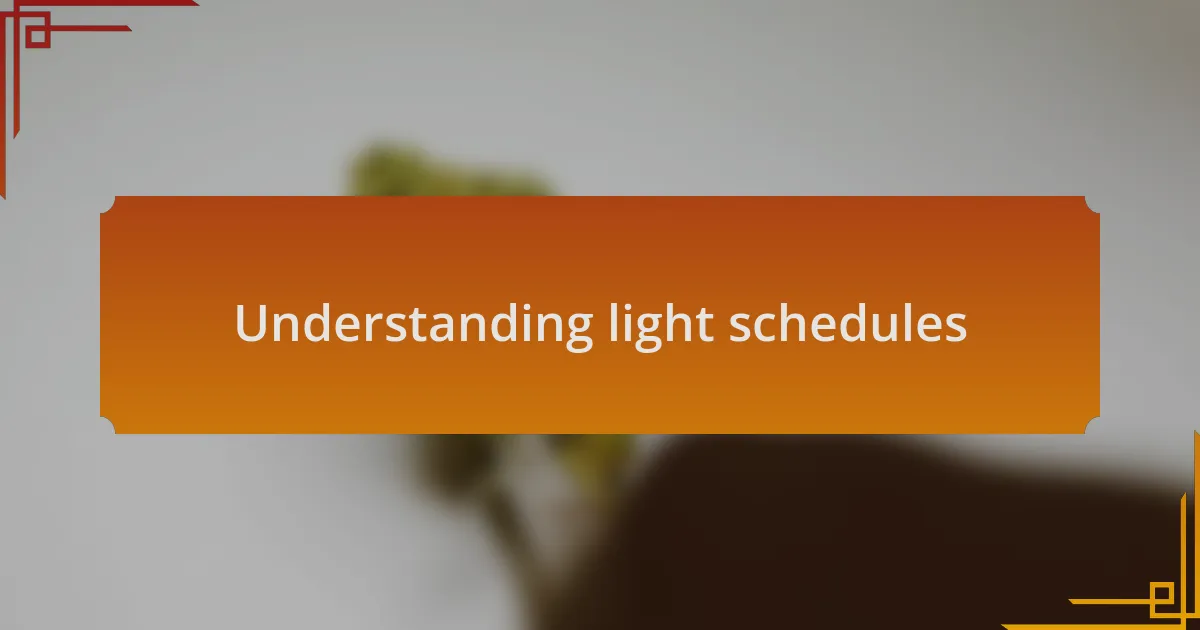
Understanding light schedules
Light schedules are crucial in the growth cycle of cannabis plants. I remember the first time I experimented with different light schedules; I was amazed at how a simple change could impact growth patterns. It’s fascinating how plants respond differently to varying light durations, isn’t it?
When planning your light schedule, you must consider the plant’s growth stage—vegetative or flowering. I’ve seen firsthand how a shift from 18 hours of light to 12 hours can trigger flowering, leading to an exhilarating transformation. Does that mean we should follow a strict routine? In my experience, consistency is vital, but being responsive to your plants’ needs is just as important.
Understanding light schedules isn’t just about hours; it’s also about the quality of light. When I switched to full-spectrum LED lights, I noticed a significant increase in density and resin production. Have you ever pondered how the right light can elevate your plants’ potential? The right light spectrum can truly make a world of difference, nurturing your plants beautifully through their lifecycle.

Importance of light in cannabis
Light plays an essential role in cannabis cultivation, acting as the driving force behind photosynthesis. When I first witnessed how my plants responded to different light intensities, I felt a profound sense of connection to their growth process. It’s incredible to think that every beam of light they experienced contributed to their health and vitality.
Moreover, the specific light spectrum influences not just growth but also bud structure and flavor profiles. I once had a strain that did nothing remarkable under standard fluorescent lights, yet, when I invested in high-quality HPS bulbs, the transformation was jaw-dropping. Have you ever noticed how some strains can really shine when given the optimal light conditions? It’s like uncovering hidden potential.
Proper light management can also help combat common issues like stretching or poor yield. I remember a particularly challenging grow where I couldn’t get the plants evenly spaced beneath the lights. The difference it made when I adjusted my setup to ensure even light distribution was like night and day. How can we underestimate the power of light when it practically shapes the future of our plants? Understanding this aspect was a game-changer for me, reinforcing the importance of light in successful cannabis cultivation.
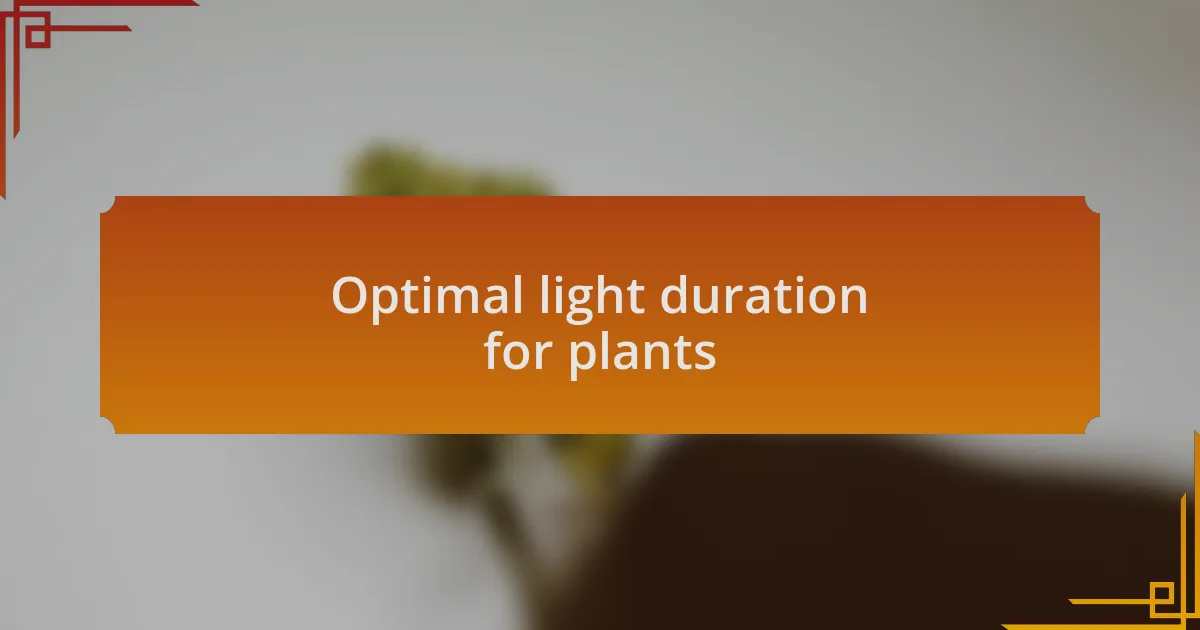
Optimal light duration for plants
When it comes to the optimal light duration for cannabis plants, I’ve found that consistency is key. For vegetative stages, I usually stick to a solid 18 hours of light, which seems to keep my plants vigorous and thriving. This duration allows them to soak in just enough energy without stressing them out—have you noticed how overexposure can lead to drooping leaves?
As flowering begins, I shift to a 12-hour light schedule. This switch truly marks the transition for my plants, triggering that magnificent bud formation. The first time I tried this, I was a bit anxious, worrying whether the plants would respond positively. Seeing those buds develop felt incredibly rewarding, reaffirming that the right light duration can transform potential into tangible results.
It’s fascinating how even small adjustments in light hours can lead to significant differences in growth. During one of my grows, I inadvertently shortened the light cycle by an hour, and the effects were noticeable; the plants seemed less robust, and the final yield suffered. Do you think a simple tweak like that could change your approach to light management? I’ve learned that every minute counts in the delicate rhythm of cannabis cultivation.
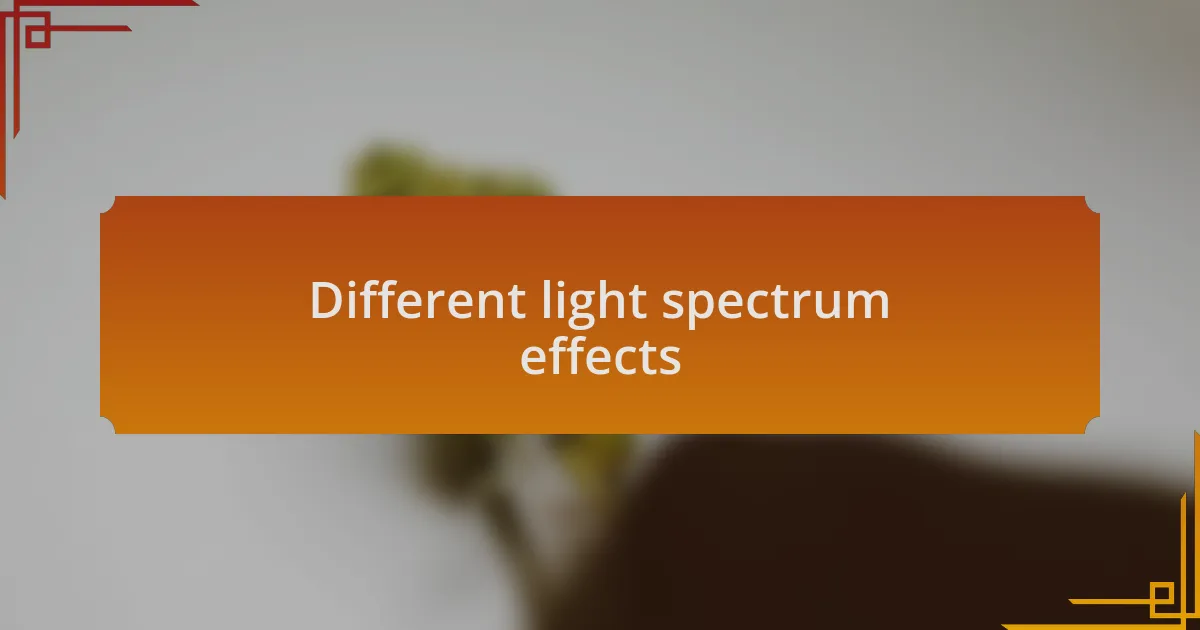
Different light spectrum effects
The light spectrum is crucial in shaping the growth and health of cannabis plants. In my experience, blue light, which tends to dominate in the vegetative stage, promotes leaf development and sturdy stems. I once experimented with different light sources during this phase, and the results were astounding—plants under stronger blue light appeared lush and vibrant, a huge boost to my early harvest enthusiasm.
As flowering kicks in, the red spectrum becomes essential. I remember my first time switching to red-focused lights; it felt like watching magic unfold. The buds were larger and fuller than I had ever achieved before. Red light stimulates flowering, and I found that my plants responded favorably to this shift, further reinforcing the importance of adjusting the light spectrum at various growth stages.
But have you pondered the impact of full-spectrum light? I’ve found it to be a game changer. When I transitioned to a full-spectrum LED, the vibrancy of my plants increased dramatically. They not only looked healthier but their aroma was also more pronounced. The versatility of such lights provides a well-rounded growth experience, and honestly, I believe they are indispensable for any serious grower looking to elevate their results.
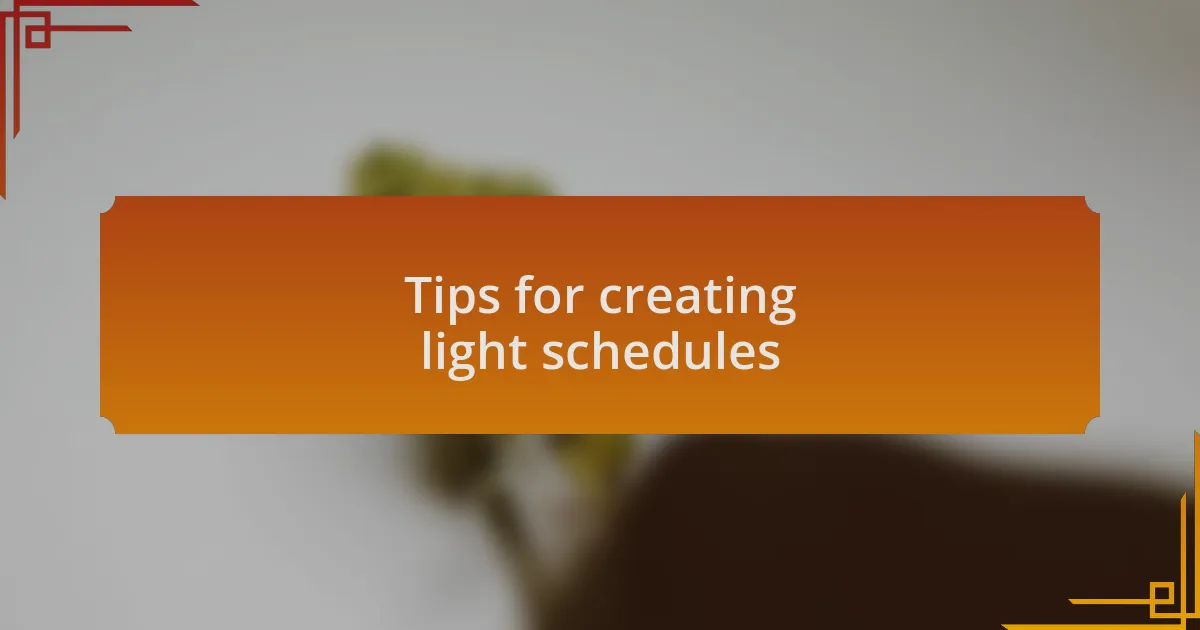
Tips for creating light schedules
Creating an effective light schedule is all about timing and consistency. I’ve personally found that using a 18/6 light cycle during the vegetative stage was key for my plants’ health. Seeing my cannabis plants thrive during those extended light hours always brought a sense of satisfaction; they stretched towards the lights with a vigor that was infectious.
As I moved into the flowering phase, I opted for a more intense light schedule with 12 hours of light and 12 hours of darkness. Honestly, my first attempt at this was nerve-wracking—would the darkness truly trigger the flowering? To my delight, it did! The transformation was rewarding, as I watched buds form and flourish in response to that consistent rhythm. It made me appreciate how the right light schedule can create a natural flow for growth.
One thing to remember is that environmental factors also play a role. During one grow, I noticed that adjusting the light schedule to align with temperature fluctuations outside led to unexpected improvements in growth. Have you considered how your grow space’s temperature might affect your plants? I believe the synergy between light and environment is something many growers overlook and it can really enhance the overall success of your cultivation efforts.
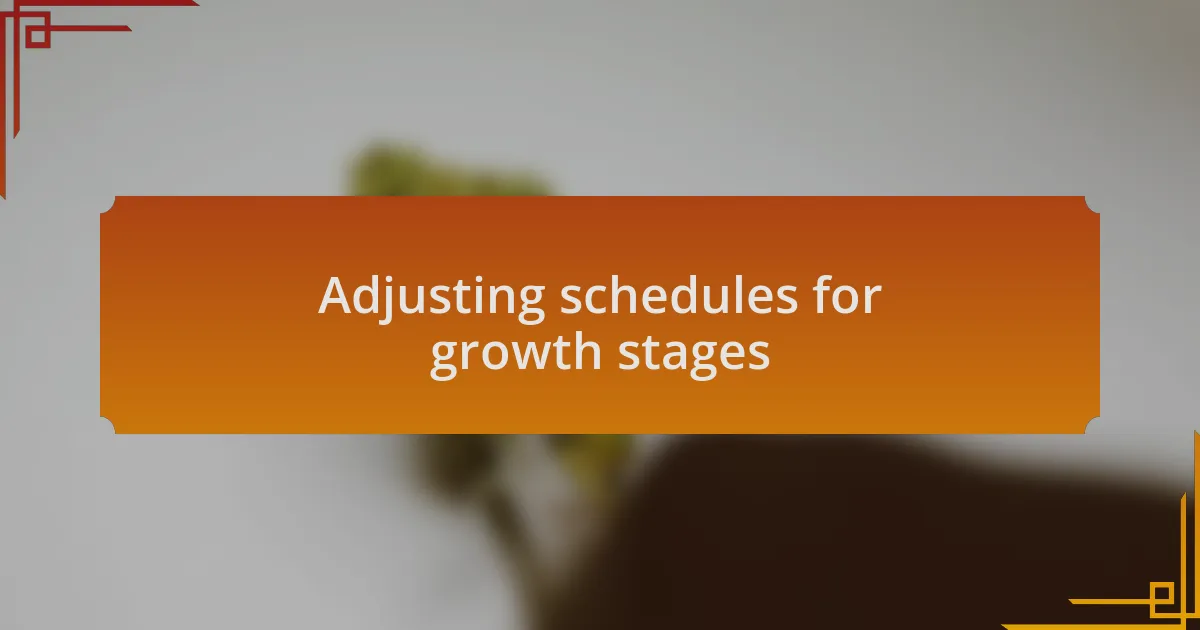
Adjusting schedules for growth stages
In my experience, adjusting light schedules according to specific growth stages is essential for optimal cannabis development. During the seedling stage, I found that offering around 18 hours of light worked wonders. My seedlings seemed to eagerly stretch for the light, and I remember the sheer joy of watching them grow strong and resilient, indicating they were thriving in that early phase.
When my plants transitioned into flowering, I deliberately shortened the light exposure to 12 hours. This adjustment felt like a leap of faith; however, seeing the first signs of flowering made me realize how critical that change is. Have you ever experienced the thrill of watching those tiny buds begin to form? It’s a reminder of how important it is to align your light schedule with the natural cycles of the plant.
One key observation I made during my grows was the effect of fluctuating light intensity during the flowering phase. I experimented by dimming the lights slightly at certain intervals, and to my surprise, this seemed to enhance bud production. It left me wondering: could varying light intensity mimic the natural conditions in the wild, where sunlight isn’t always consistent? Embracing this approach enriched my understanding and outcomes, highlighting how adaptable our light schedules can be for better growth results.
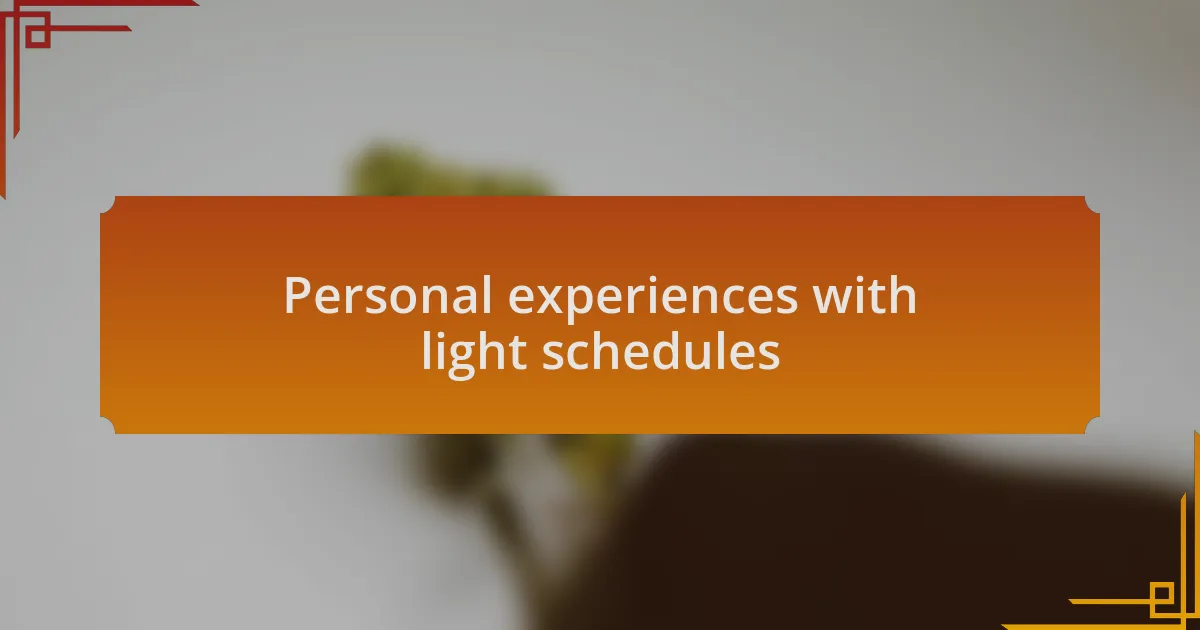
Personal experiences with light schedules
I vividly recall my initial attempts to fine-tune light schedules and how it transformed my growing experience. It was during one particularly hot summer when I accidentally left the lights on longer than planned. Instead of panic, I embraced the situation, observing how my plants seemed to thrive in those extra hours. The vibrant growth that followed led me to wonder if more isn’t always better, but rather, if flexibility could play a role in encouraging resilience.
As I became more confident with my light schedules, I started documenting how different strains responded to varying conditions. I distinctly remember my first encounter with a strain known for its finickiness—every minor adjustment felt like a gamble. When I reduced the light to 10 hours during a particularly stressful phase, I felt nervous. Yet, I watched in awe as my plants adapted and produced the most fragrant buds I had ever encountered. Have you ever observed that exhilarating moment when all your efforts pay off? It reinforces the idea that sometimes, listening to your plants can lead to delightful surprises.
Another significant lesson emerged from a side-by-side comparison experiment: one room under a consistent light regime while the other flickered at intervals. The room with fluctuating lights not only produced denser buds but also exhibited a remarkable range of colors. I was left pondering how much plants really respond to their environments. What if simply changing our light schedules could unlock even more potential? That curiosity continues to fuel my exploration, and I invite you to reflect on your own experiences as you consider the rhythm of nature in your growing space.